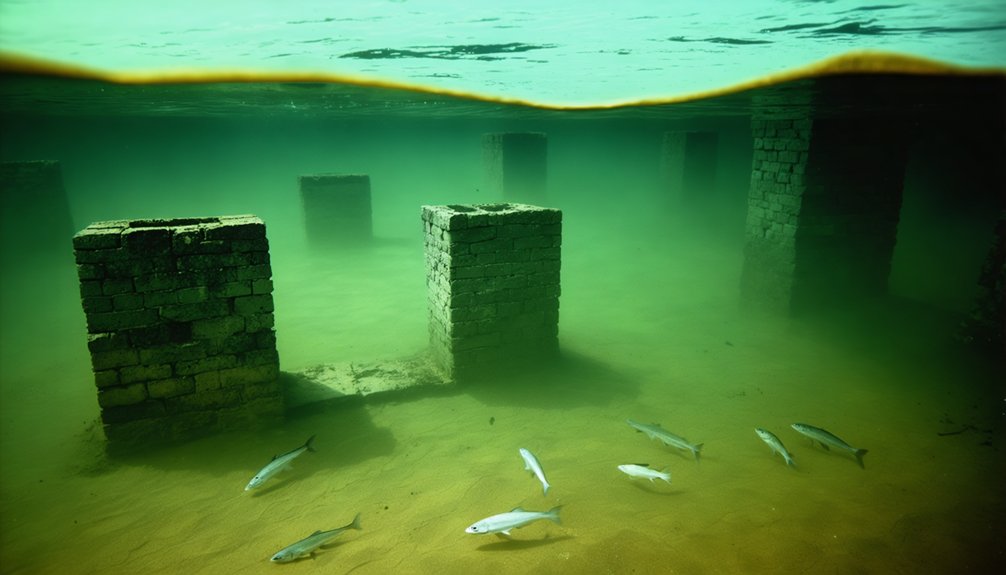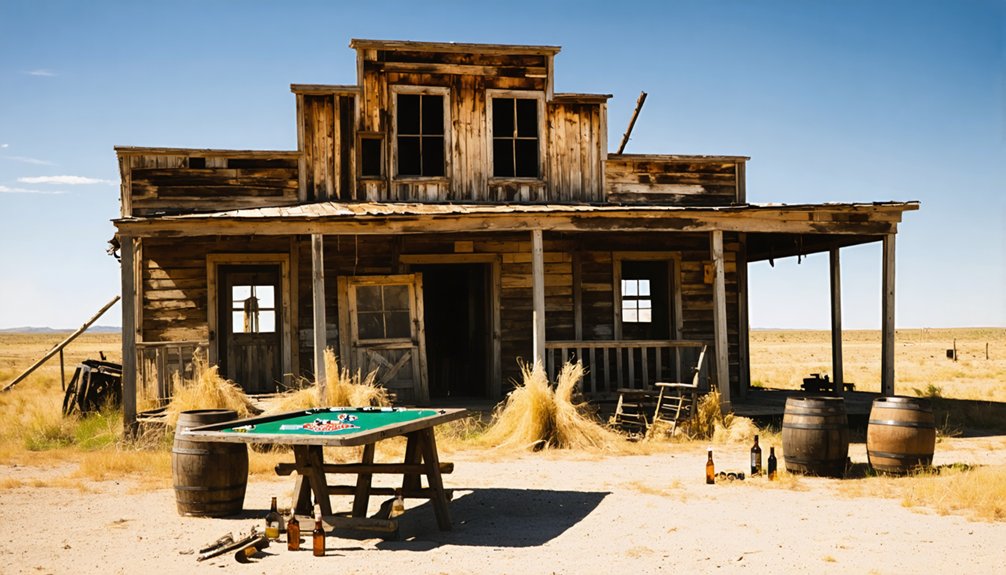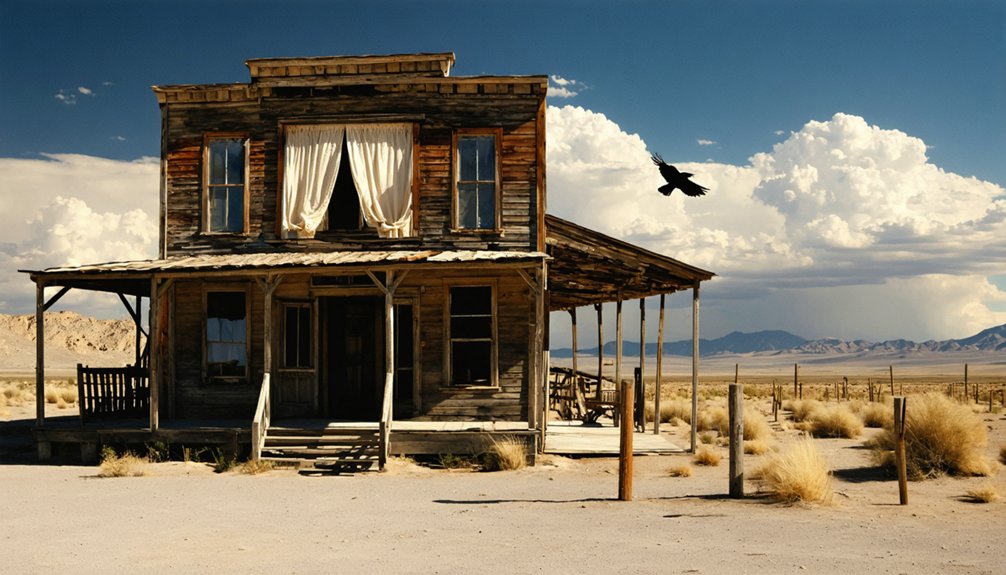You’ll find the ghost town of Dodge City, Texas submerged beneath Lake Travis’s waters since 1941, when the Mansfield Dam construction flooded this once-bustling frontier settlement. Originally established in 1871 near present-day Volente, the town flourished as an essential Colorado River trading post with log cabins and frontier buildings. Today, you can explore two authentic relocated structures at Fort Tumbleweed, where each preserved log tells a deeper story of Texas’s pioneering spirit.
Key Takeaways
- Dodge City, Texas was a frontier settlement established in 1871 that now lies submerged beneath Lake Travis.
- The town originally featured saloons, trading posts, and frontier buildings before being flooded by Mansfield Dam construction in 1941.
- Two authentic log cabins from the original Dodge City were preserved and relocated to Fort Tumbleweed.
- The ghost town’s remnants occasionally become visible during severe droughts, revealing pre-lake Texas history.
- Located near present-day Volente, Texas, Dodge City was once a bustling frontier community along the Colorado River.
The Early Days Along the Colorado River
While Spanish explorers initially confused the Colorado River with the Brazos, this mighty waterway stretching 862 miles through Texas would shape the destiny of Dodge City and its surroundings.
The 7 U.S. states rely on this critical water source, illustrating its vast regional importance. You’ll find the river’s history deeply intertwined with the Comanche tribes, who fiercely controlled the upper regions throughout the 18th century, limiting European settlement attempts. The Spanish attempted to establish Mission Santa Cruz but faced devastating attacks from the native tribes.
After Texas gained independence in 1836, you’d have seen river navigation flourish as steamboats connected coastal markets to inland communities.
The area’s historical agriculture took root as early farming settlements emerged, though seasonal flooding posed constant challenges.
The river’s course, which had shifted near Caney Creek a millennium ago, created fertile bottomlands dotted with oxbows and wetlands – perfect for the determined settlers who’d eventually establish Dodge City.
Founding Settlers and Their Log Cabins
As rancher Henry L. Sitler established the first permanent dwelling in 1871, you would’ve found his three-room sod house serving as both home and cattle operations center.
The founding families who followed built a mix of sod houses and frame structures, adapting to the prairie’s limited timber resources. Early architecture reflected the harsh realities of frontier life, with hastily constructed buildings rising to meet the needs of settlers drawn by Fort Dodge and the Santa Fe Trail. The settlement became notorious for its violent gunfighter culture, with numerous saloons and gambling halls dotting the landscape. Early streets were designed unusually narrow to accommodate the passage of bull trains through town.
You’ll find that these pioneering structures weren’t just homes – they transformed into trading posts, saloons, and commercial hubs as the community grew.
When the railroad arrived in 1872, the settlement’s strategic location turned it into a bustling center for buffalo hunting and later, the cattle trade.
Life in the Texas Republic Era
The raw frontier spirit of Dodge City emerged during its early years, when a transient population of buffalo hunters, railroad workers, and ex-Confederate cowboys shaped its wild character. You’d find yourself amid frontier lawlessness, where shootouts and saloon brawls were commonplace until lawmen like Bat Masterson brought some semblance of order. The town’s early conflicts led to the creation of Boot Hill Cemetery. The Atchison, Topeka & Santa Fe Railroad’s arrival in 1872 triggered explosive growth in the frontier town.
The town’s lifeblood flowed through massive cattle drives, with over 5 million head moving through on the Chisholm Trail.
Millions of hooves thundered through Dodge City, as cattle drives turned the frontier outpost into a bustling hub of commerce.
- Front Street bustled with saloons, dance halls, and brothels where you’d rub shoulders with immigrants and opportunists.
- You’d see mostly male settlers and seasonal workers, swelling the population during peak trading times.
- Your home might be a simple tent or sod house near the railroad tracks, where property claims often sparked heated disputes.
The Webster Massacre and Frontier Dangers
During Texas’ frontier expansion in 1839, you’d have witnessed one of the deadliest Comanche raids near present-day Leander, where John Webster’s settlement party of 30-40 men met a tragic end at the hands of hundreds of warriors.
Mrs. Webster and her children faced months of captivity before eventually making their way to safety in San Antonio.
You would’ve seen the settlers form a defensive square with their covered wagons at Brushy Creek, fighting desperately until all the men were killed and scalped by mid-morning.
Local men from Tumlinson’s Fort ventured out to hastily bury the dead settlers, working quickly due to ongoing safety concerns in the area.
The massacre’s aftermath left Webster’s family captured and the surviving frontier communities deeply shaken, spurring heightened vigilance against raids and illustrating the deadly reality of westward settlement in the Republic of Texas era.
Comanche Raid’s Deadly Toll
In one of Texas’s most devastating frontier attacks, approximately 300 Comanche warriors descended upon John Webster’s party of 40 settlers near present-day Leander in August 1839. The Comanche warfare tactics proved lethal as they repeatedly charged the wagon train, shooting with deadly accuracy until all male defenders fell. Martha Webster endured severe whipping and burning during her time as a captive.
- Chiefs Guadalupe, Yellow Wolf, and Buffalo Hump led the assault that overwhelmed the settlers’ defensive perimeter.
- The raiders burned the wagons, seized valuables, and took Mrs. Webster, her children, and a black woman captive.
Like the later Council House Fight of 1840, this attack sparked a cycle of brutal retaliation between settlers and Comanche warriors.
Despite brutal captivity conditions, the Webster family’s settler resilience prevailed – they eventually escaped through help from traders and other Native groups.
The massacre’s impact reverberated through the Texas frontier, becoming a stark reminder of the dangers faced by those seeking freedom in the West.
Settlers Face Frontier Peril
Facing overwhelming odds near present-day Leander, Texas, John Webster’s party of 40 settlers encountered their worst nightmare when 300 Comanche warriors descended upon them in June 1839.
You’d have witnessed remarkable settler resilience as they formed a defensive square with covered wagons, fighting from sunrise until 10 PM against relentless mounted attacks.
Despite their brave stand, frontier violence claimed all male defenders.
Mrs. Webster, her children, and a black servant survived through captivity. Martha Virginia Webster Strickling endured brutal treatment including whipping and burning before eventually escaping with her mother and brother.
Though they were later recaptured and traded, their survival story exemplifies the determination of frontier families.
Today, two monuments in Leander and a mass grave at Davis Cemetery mark this pivotal moment in Texas frontier history.
Lost to the Waters of Lake Travis

The waters of Lake Travis claimed Dodge City when the damming of the Colorado River transformed the Texas Hill Country landscape.
Beneath Lake Travis lies a drowned piece of Texas history – Dodge City, forever lost to progress and rising waters.
You won’t find the original settlement near present-day Volente anymore – it’s deep beneath the reservoir’s surface, a submerged history of Texas frontier life. While most of the town’s log cabins disappeared under the rising waters, two structures escaped preservation through relocation to Fort Tumbleweed near Liberty Hill.
- Dodge City’s fate mirrors other Texas communities sacrificed for flood control and water supply
- You can still visit the rescued cabins at Fort Tumbleweed on weekends
- The transformation from frontier settlement to lake bottom represents the price of progress
The town’s submersion was part of a larger change that reshaped the region, as Lake Travis swallowed multiple communities along the Colorado River’s path.
Surviving Structures at Fort Tumbleweed
While Lake Travis claimed most of Dodge City, you can still explore two authentic log cabins that were rescued and relocated to Fort Tumbleweed, where they stand as rare physical remnants of the original settlement.
The preserved structures showcase traditional frontier construction methods, including horizontal log notching typical of early Texas pioneer buildings.
You’ll find these historic cabins open for tours on weekends at Fort Tumbleweed’s 16-acre site in Liberty Hill, where they continue to tell the story of early Colorado River settlements.
Log Cabin Preservation Details
Private collectors Len and Linda Kubiak have dedicated themselves to preserving authentic 1800s structures at Fort Tumbleweed through meticulous restoration efforts.
Their log cabin techniques focus on maintaining historical accuracy while battling preservation challenges like environmental threats and resource constraints.
You’ll find these carefully restored buildings showcase traditional Texas construction methods, with oak and cedar logs hand-hewn and squared for permanence rather than temporary shelter.
The preservation process includes:
- Dismantling structures piece-by-piece from original locations
- Using modern compounds like Log Jam for enhanced durability while maintaining authentic appearance
- Documenting each cabin’s history and architecture to guarantee accurate restoration
The Kubiaks’ work provides you with an immersive glimpse into frontier life through these preserved structures, which now serve as educational venues for community events and historical tours.
Original Settlement Features Preserved
Building upon the Kubiaks’ preservation work, Fort Tumbleweed stands as a remarkable collection of original frontier structures that paint a vivid picture of 19th-century Texas life.
You’ll find the historic Andice Saloon, relocated from its original location, showcasing authentic settlement architecture with its period-correct stone and wood construction.
The site’s preserved artifacts include a working blacksmith shop with its original coal forge, while nearby, you’ll discover the Tonkawa Indians’ spring that predates European settlement.
The stagecoach and trading post structures reveal the settlement’s commercial heritage, complete with local artists’ historical paintings.
Mixed-use residential buildings and community structures round out the authentic frontier experience, featuring traditional building techniques using sod, wood, and stone.
Weekend Tours and Access
Fort Tumbleweed welcomes visitors exclusively on weekends at its 16450 West HW 29 location near Liberty Hill, Texas.
During your weekend visit, you’ll explore authentic log cabins relocated from the original Dodge City settlement, providing a tangible connection to Texas frontier life.
The historical tours highlight:
- Two preserved log cabins that stand as the last physical remnants of Dodge City
- Original construction techniques and materials that showcase pioneer craftsmanship
- Stories of early Texas settlers who faced Comanche conflicts and environmental challenges
While weekend accessibility remains limited to protect these fragile structures, you’ll experience the quiet rural setting much as early settlers did.
You’re free to photograph the historic buildings while learning about the Colorado River settlements that preceded Lake Travis.
The site’s preservation efforts guarantee these authentic pieces of Texas history endure for future generations.
A Tale of Two Dodge Cities
While many frontier towns grew from a single settlement, Dodge City’s story uniquely involves two distinct but intertwined communities.
You’ll find Fort Dodge, established in 1865 as a military outpost protecting Santa Fe Trail travelers, and five miles away, the civilian settlement that would become Dodge City, Kansas, emerging in 1872 around Henry L. Sitler’s sod house.
The military fort, named after General Grenville Dodge, provided essential protection and a steady stream of soldiers who frequented the new town’s establishments.
Fort Dodge’s soldiers brought both safety and steady business to the frontier town’s bustling establishments.
When buffalo hunters and Texas cattle drovers flooded into the area, they found two complementary communities – one maintaining order through military might, the other offering the wild freedoms of the frontier through its saloons, gambling halls, and trading posts.
Legacy of a Frontier Settlement

The strategic positioning of Dodge City along the Santa Fe Trail shaped its enduring legacy as a quintessential American frontier settlement.
You’ll find its frontier resilience reflected in the transformation from a wild cattle town into an organized municipality, where lawmen like Wyatt Earp and Bat Masterson tamed the streets. The town’s cultural nostalgia endures through its compelling narrative of western expansion and adaptation.
- The convergence of military protection from Fort Dodge, crucial water resources from the Arkansas River, and the railroad’s arrival created perfect conditions for growth.
- Law enforcement evolution from gunfighter territory to structured governance demonstrates the settlement’s maturation.
- Despite sensationalized accounts, Dodge City represents the real struggles and triumphs of American frontier life.
Visiting the Historic Cabin Remnants
Located beyond the bustle of modern Dodge City, scattered cabin remnants offer glimpses into frontier life that shaped this legendary Kansas settlement.
Your cabin exploration will take you down rural roads to sites where foundation stones, crumbled adobe walls, and weathered timbers tell tales of early settlers’ determination. You’ll need to secure permission for sites on private land and bring essential supplies, as these remote locations lack modern facilities.
These humble structures, with their simple one-room designs and primitive hearths, carry profound historical significance.
They’re silent witnesses to buffalo hunters, cattle traders, and pioneering families who carved out lives here.
While photographing these fragments of the past, watch your step around unstable structures and respect these vulnerable pieces of frontier heritage.
Impact of Modern Development on Texas History

You’ll find Dodge City’s once-bustling pioneer buildings now partially submerged beneath Lake Travis’s waters, a stark reminder of how modern infrastructure projects can permanently alter historic landscapes.
The original log cabins that dotted this Texas ghost town were carefully relocated before the lake’s formation, preserving fragments of 19th-century frontier life for future generations.
While the dam’s construction brought essential resources to Central Texas, it came at the cost of obscuring significant heritage sites, including trading posts and early settlements that once marked this historic community.
Lake Travis Submerges History
Since construction of Mansfield Dam in 1941, Lake Travis’s rising waters have submerged countless pieces of Central Texas history beneath its surface.
The dam’s creation flooded pioneer homesteads, Native American sites, and essential infrastructure like Lohman’s Bridge, challenging lake preservation efforts and limiting submerged archaeology research.
You’ll find these historic remnants revealed only during severe droughts when water levels drop considerably.
- The Shaker Plant’s industrial ruins lie hidden beneath the surface, a reflection of the dam’s own construction history
- “Sometimes Islands” emerge during low water periods, offering rare glimpses of pre-lake Texas
- Historic transportation routes and community frameworks vanished as flood control took priority over heritage preservation
Today, while you enjoy Lake Travis’s recreational offerings, remember you’re floating above a drowned landscape of early Texas frontier life.
Relocated Pioneer Log Cabins
As modern development sweeps across Texas, many pioneer log cabins have found new homes through careful relocation efforts. You’ll find these historic structures preserved in heritage parks and museums across the state, where they continue telling stories of early settler life.
Cabin relocation isn’t without its challenges. When you visit these relocated structures, you’re seeing the results of complex preservation challenges that include dismantling, transporting, and reassembling these delicate pieces of history.
While the original setting can’t be perfectly replicated, these moves often save cabins from destruction due to urban expansion and development pressures. Through specialized restoration techniques and careful documentation, Texas historical societies work to maintain the authenticity of these structures, ensuring you can experience firsthand the architectural heritage of pioneer Texas.
Infrastructure Versus Heritage Sites
While pioneer log cabins have found new homes through preservation efforts, modern Texas faces a broader challenge in balancing infrastructure needs with heritage conservation.
You’ll find infrastructure decay accelerating in former boomtowns, where aging water systems, electrical grids, and roads threaten both development potential and heritage preservation. When you explore these forgotten places, you’ll witness the stark reality of progress versus history.
Key challenges you’ll encounter in Dodge City and similar ghost towns:
- Remote locations limit access to modern utilities, making restoration costly
- Environmental contamination from past industries blocks viable redevelopment
- Fragmented property ownership prevents unified conservation efforts
The town’s future hangs in the balance as infrastructure demands clash with the need to protect Texas’s historical legacy, reflecting a common struggle across the state’s rural landscape.
Frequently Asked Questions
Were There Any Notable Gunfights or Duels in Dodge City, Texas?
Like birds seeking the wrong nest, you’re mixing up your cities. The famous gunfight history and duel legends you’re thinking of happened in Dodge City, Kansas, not Texas.
What Native American Tribes Lived in the Area Before Settlement?
You’d find the Kiowa and Comanche were prominent native tribes in this area, with their cultural impact visible through buffalo hunting patterns. The Cheyenne, Tonkawa, and Pawnee also moved through these lands.
How Deep Underwater Are the Original Town Ruins Today?
While underwater exploration varies by season, you’ll find the ruins about 35-40 meters deep. That’s 115-130 feet underwater, though historical preservation efforts show some structures become visible during extreme droughts.
Did Any Famous Texas Historical Figures Visit the Settlement?
You won’t find records of any notable visitors or famous Texas figures at this settlement. While it held historical significance for cattle drives, documented visits by prominent personalities don’t exist.
What Crops or Livestock Did the Original Settlers Primarily Raise?
You’d think pioneers focused on crop cultivation, but they actually centered on cattle ranching, bringing Texas longhorns to this settlement. Limited grain farming existed mainly to support the bustling livestock trade.
References
- https://fordcountyhistory.org/books/early-ford-county/chapter-four-dodge-city-and-other-towns/
- https://www.legendsofamerica.com/ks-dodgecity/
- https://www.youtube.com/watch?v=YLn7k8c18rI
- https://www.ebsco.com/research-starters/history/historic-dodge-city
- https://www.ghosttowns.com/states/tx/dodgecity.html
- https://en.wikipedia.org/wiki/Dodge_City
- https://petticoatsandpistols.com/2019/07/16/the-ghosts-of-old-tascosa/
- https://livefromthesouthside.com/10-texas-ghost-towns-to-visit/
- http://www.prigussport.com/dodge-city-ghosts
- https://www.dodgecity.org/420/Department-History



